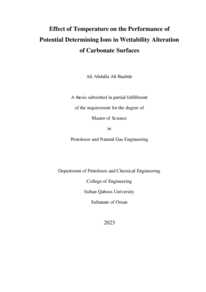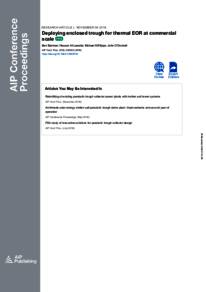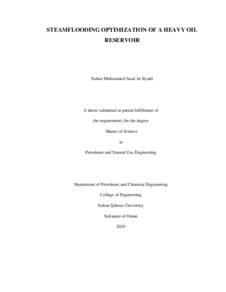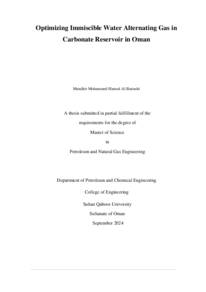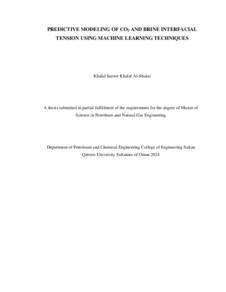Document
Effect of temperature on the performance of potential determining ions in wettability alteration of carbonate surfaces.
Source
Master's thesis
Other titles
تأثير درجة الحرارة على أداء PDIs في تغير قابلية البلل لأسطح الكربونات
Country
Oman
City
Muscat
Publisher
Sultan Qaboos University
Gregorian
2023
Language
English
Thesis Type
Master's thesis
English abstract
Improving oil recovery in carbonate reservoirs using low salinity/smart water has
been proven to be an efficient technique in the petroleum industry. It has been agreed
in literature that a brine of salinity lower than that of formation water enhances the
sweep efficiency by wettability alteration. However, the efficiency of the smart water
depends on the chemical activity of the surface modifying agents known as the potential
determining ions (PDIs); Ca2+, Mg2+ and SO4
2-
, which is temperature dependent.
Therefore, a comprehensive understanding of the effect of temperature on the PDIs
during smart water injection is a key factor for the success of the process.
This study aimed to investigate the effect of temperature on the activity of the PDIs
as well as their interactions in modifying the wettability of oil-aged carbonate surfaces
(calcite and dolomite). Temperatures of 25, 50, 75, 100 and 125 °C, representing global
carbonate reservoir temperatures, were selected for the study. Wettability alteration was
evaluated through contact angle (CA) measurement, while the effect of temperature on
the surface charges at the fluid/rock interface was analyzed using zeta potential
measurement. The concentrations of the PDIs before and after treatment were analyzed
to gain an insight of the driving mechanism that led to wettability alteration towards a
water-wet state.
Results showed a decreasing trend of CA and a shift in wettability towards more
water wetness for both mineralogies with temperature elevation, more significant at
temperatures greater than 75 °C for all the three individual PDIs. However, this shift in
wettability necessitates both high temperature and the presence of PDIs in the treating
solution as no significant change in wettability was recorded after treatment of the
carbonate surfaces with deionized water (DIW). Additionally, it was observed that
Mg2+/SO4
2-
combination had a better performance than Ca2+/SO4
2-
combination at all
temperatures for both carbonates. The strongest water-wet calcite surface resulted after
treatment with smart water containing all the three PDIs at 125 °C, while the same was
observed for dolomite after treatment with Mg2+/SO4
2-
combination at the same
conditions.
Zeta potential results showed a charge reversal from negative to positive after
treatment of the carbonate particles with all tested smart waters except the smart water
containing only SO4
2-
. A significant shift in surface charge was observed as temperature
increases to 125 °C, which is in-line with CA results. Ions analysis of the smart water
solutions after treatment with both carbonates revealed that the concentration of SO4
2-
ions decreases with temperature, which is due to adsorption of the negatively charged
ions on the rock surface. The final concentrations of Mg2+ and Ca2+ ions in the treating
solution is however greater than its initial concentrations, which is a result of both
dissolution and removal of the Ca/Mg- Carboxylate complexes from the surface,
producing water-wet surfaces.
Overall, the results confirm that an increase in temperature enhances the multi-ion
exchange (MIE) between the ions in the solution and the carbonate surface. However,
the interplay between the ions and the reaction kinetics not only depend on the
temperature, but also on the surface mineralogy as well as the ion composition of the
smart water.
Arabic abstract
تعتبر تقنية الاستخلاص المعزز للنفط في مكامن الكربونات باستخدام المياه منخفضة الملوحة/ المياه الذكية تقنية فعالة في صناعة النفط. الدراسات السابقة اوضحت أن استخدام محلول أقل ملوحة من ماء المكمن النفطي يعزز كفاءة استخلاص النفط عن طريق تغيير قابلية البلل لصخور المكمن. ومع ذلك، فإن كفاءة المياه الذكية تعتمد على النشاط الكيميائي لعوامل تعديل خصائص الاسطح والمعروفة باسم الايونات المحددة المحتملة (PDIs (والتي 2- تشمل ايونات الكالسيوم والمغنيسيوم والكبريتات ) , SO4 Ca)، والتي تتأثر بدرجة الحرارة. لذلك، فإن 2+ Mg , 2+ الفهم الشامل لتأثير درجة الحرارة على ال PDIs أثناء الحقن الذكي للمياه عامل رئيسي لنجاح العملية. هدفت هذه الدراسة إلى معرفة تأثير درجة الحرارة على نشاط ال PDIs بالاضافة إلى تفاعالتها التي ممكن ان تؤدي الى تعديل قابلية البلل لأسطح الكربونات الزيتية )الكالسيت والدولوميت(. تم اختيار درجات حرارة ،25 ،50 ،75 100 و125 درجة مئوية، والتي تمثل درجات حرارة لمكامن كربونات معروفة عالميا للدراسة. تم تقييم قابلية تغير تبلل الاسطح من خلال قياس زاوية التلامس بين الصخر والسائل، بينما تم تحليل تأثير درجة الحرارة على شحنات السطح البيني بين المائع/الصخر باستخدام قياس جهد زيتا )فرق الجهد عبر حدود الطور بين المواد الصلبة والسوائل(. تم تحليل تراكيزالايونات قبل وبعد المعالجة بمحاليل ال PDIs للحصول على نظرة ثاقبة على الالية التي أدت إلى تغيير قابلية بلل الاسطح نحو حالة الترطيب بالماء. النتائج اتجا ًها متناق ًصا لزاوية التلامس وتحوًال اظهرت في قابلية البلل نحو المزيد من رطوبة الماء لكال السطحين مع ارتفاع درجة الحرارة وخاصة عند درجات حرارة أعلى من 75 درجة مئوية لجميع ايونات ال PDIs الفردية. ومع ذلك، فإن هذا التحول في قابلية البلل يستلزم درجة حرارة عالية ووجود ال PDIs في محلول المعالجة حيث لم يتم تسجيل أي تغيير كبير في قابلية البلل بعد معالجة أسطح الكربونات بالماء منزوع الايونات )DIW). 2- بالاضافة إلى ذلك، لوحظ أن تركيبة 2- كان لها أداء أفضل من تركيبة 2+Mg 4SO/ /SO4 Ca في جميع درجات 2+ الحرارة لكال سطحي الكربونات. نتج أقوى سطح كالسيت مائي رطب بعد المعالجة بالمياه الذكية التي تحتوي على جميع ال PDIs الثالثة عند 125 درجة مئوية، بينما لوحظ نفس الشيء بالنسبة للدولوميت بعد المعالجة بمركب 2- في نفس الظروف. 2+Mg 4SO/ أظهرت نتائج جهد زيتا تحول شحنة السطح من السالب إلى الموجب بعد معالجة جزيئات الكربونات بجميع -2 المياه الذكية المختبرة باستثناء المياه التي تحتوي على 4SO فقط. لوحظ كذلك تحول كبير في شحنة الاسطح مع ارتفاع درجة الحرارة إلى 125 درجة مئوية، وهو ما يتماشى مع نتائج زاوية التالمس. أظهرتحليل تركيزالايونات 2- لمحاليل المياه الذكية بعد معالجة أسطح الكربونات )الكالسيت والدولوميت(، أن تركيز أيونات 4SO يتناقص مع درجة الحرارة، وذلك بسبب امتزاز الايونات سالبة الشحنة على سطح الصخور. بينما كانت التراكيز النهائية 2+Mg أليونات و 2+ Ca في محاليل المعالجة أكبر من تراكيزاها الاولية، وذلك بسبب إذابة الاسطح وإزالة مركبات )الكربوكسيالت - Mg/Ca )من السطح، مما ينتج عنه أسطح ذات قابلية ترطيب بالماء.
Category
Theses and Dissertations

